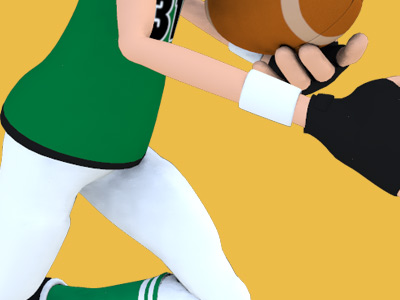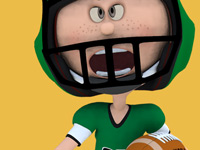American football

Victory formation (American Football Strategy)
In American football, a quarterback kneel, also called taking a knee, genuflect offense, or victory formation occurs when the quarterback immediately kneels to the ground, ending the play on contact, after receiving the snap. It is primarily used to run the clock down, either at the end of the first half or the game itself, in order to preserve a lead or a win. Although it generally results in a loss of a yard and uses up a down, it minimizes the risk of a fumble, which would give the other team a chance at recovering the ball.
Especially when the outcome of the game has been well decided, defenses will often give little resistance to the play as a matter of sportsmanship as well as to reduce injury risk on what is a relatively simple play. The quarterback is generally not touched and the act of intentionally taking the knee results in the play being over in all variations of the sport.
The formation offers maximum protection against a fumble; should the center-quarterback exchange result in a fumble, a running back is lined up on either side of the quarterback, both to recover any fumble and protect the vulnerable kneeling player from being injured by defensive players who get through the line. Also, a player is lined up directly behind the quarterback, often much farther than a typical tailback would line up. This player's responsibility is to tackle any defensive player who may recover a fumble and attempt to advance it. Because of this essentially "defensive" responsibility, the tailback in this formation may actually be a free safety or other defensive player who is adept at making tackles in the open field.
Even though the play itself takes very little time, the rules of American football dictate that it does not stop the game clock (as with any play where the ball carrier is tackled in bounds). With the 40-second play clock in the NFL and NCAA, a team can run off over two minutes with three consecutive kneel-downs if the defensive team has no more timeouts.
The play is often known as a "victory formation," as it is most often run by a winning team late in the game in order to preserve a victory. In the case of a close game, the winning team would be trying to avoid a turnover which might be the result of a more complex play; in the case of a more lopsided contest, the play can be run as a matter of sportsmanship and to avoid further injury. In terms of statistics, a kneel by the quarterback is typically recorded as a rushing attempt for –1 or –2 yards.
Strategy
The quarterback kneel may also be used at the end of the first half by a team which feels they have little chance of scoring before halftime due to poor field position. Similarly, the play could also be run at the end of the second half of a tie game if a team is content with sending the game into overtime. The play could perhaps also be run at the end of the game by a losing team which is hopelessly behind and wishes to avoid further injury, but is unwilling to cut the game short as a forfeit.
In rare instances, a team will use the quarterback kneel to avoid running up the score in a lopsided contest, even though there may be significant time remaining on the clock. This occurred in the 2011 edition of the Magnolia Bowl between the Louisiana State University (LSU) Tigers and the University of Mississippi (Ole Miss) Rebels. With five minutes remaining and LSU leading 52–3, Tigers coach Les Miles ordered third-string quarterback Zach Mettenberger to take a knee on first and goal from the Ole Miss one-yard line, and to kneel on the next three plays. Miles felt another touchdown would further embarrass Ole Miss coach Houston Nutt, who announced his resignation, effective at the end of the season, 12 days before the Rebels hosted first-ranked LSU. The Tigers had already secured the largest margin of victory in series history.
In Canadian football or arena football, which use slightly different rules, taking a knee with time left is not necessarily a viable strategy. In the CFL, a quarter must end with a play, and in arena football, teams must gain yardage in the final minute to keep the clock running.
Defense
Although in most instances a losing team will concede defeat when the other team is in the victory formation and taking the quarterback kneel, there are instances where the trailing team will try to make a defensive play in an attempt to regain possession of the ball, particularly when the losing team is behind by a touchdown or less and there is enough time to make more than one play.
This had happened on the play preceding The Miracle at the Meadowlands. Due to the low percentage of turnovers caused, defenses generally do not attempt to disrupt the kneeldown as the Eagles did in 1978; a "gentlemen's agreement" emerged in which defenders did not rush the offensive team with high intensity, as long as the offense made no attempt to advance the ball.
Aside from trying to attempt a defensive play, teams that are losing but behind by a touchdown or less in the final two minutes will sometimes use their time-outs if the team does a quarterback kneel. As teams are allowed three time-outs per half—the clock stops on a time out and restarts on the snap—they will try to preserve them for situations such as this, thereby forcing the winning team to run a play and gain a first down or, in the very least, take time off the clock. If there is still enough time left on the clock and the winning team attempts another quarterback kneel, the defensive team's strategy may repeat itself until it either runs out of time-outs, time runs out, or (most desirably) the team forces a punt or turnover.
Rules
The 2011 NFL Rules state in Rule 7, Section 2, Article 1(c): "An official shall declare the ball dead and the down ended … when a quarterback immediately drops to his knee (or simulates dropping to his knee) behind the line of scrimmage".
The 2011 and 2012 NCAA Rules state in Rule 4, Section 1, Article 3(o): "A live ball becomes dead and an official shall sound his whistle or declare it dead … When a ball carrier simulates placing his knee on the ground." The same rule is used by the British American Football Association.
The 2011 CFL Rules state in Rule 1, Section 4: "The ball is dead … When the quarterback, in possession of the ball, intentionally kneels on the ground during the last three minutes of a half". The Statistical Scoring Rules, Section 5(e) states: "When a quarterback voluntarily drops to one knee and concedes yards in an effort to run out the clock, the yards lost will be charged under Team Losses. NOTE – No quarterback sack will be given in this situation."
SPORTS



American Football
Game play in American football consists of a series of downs, individual plays of short duration, outside of which the ball is dead or not in play. These can be plays from scrimmage – passes, runs, punts, or field goal attempts (from either a place kick or a drop kick) – or free kicks such as kickoffs and fair catch kicks. Substitutions can be made between downs, which allows for a great deal of specialization as coaches choose the players best suited for each particular situation. During a play, each team should have no more than 11 players on the field, and each of them has specific tasks assigned for that specific play.
Rules and gameplay
- Scoring
- Maneuvers
- Strategy
- Play types
- Penalties
- Turnovers
- Downs
- Teams and positions
- Field
- Equipment
- Duration and time stoppages
- Advancing the ball and downs
- Kicking
- Officials and fouls
Positions
Offensive (Interior) line
Backs and receivers
Defensive line
Linebackers
Defensive backs
Special teams
- Kicker (K)
- Holder (H)
- Long snapper (LS)
- Punter (P)
- Kickoff specialist (KOS)
- Kick returner (KR) and Punt returner (PR)
- Upback
- Gunner
- Jammer


RESOURCES
This article uses material from the Wikipedia articles "American football", "American football rules", "Strategy", "Quarterback kneel", which is released under the Creative Commons Attribution-Share-Alike License 3.0.
© Stories Preschool. All Rights Reserved.





